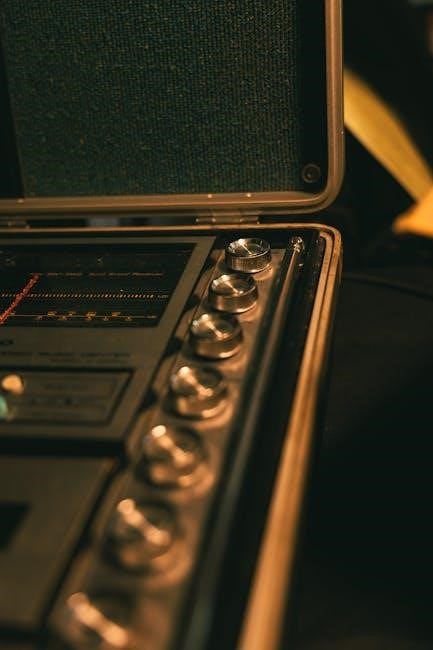Small Signal Audio Design by Douglas Self is a comprehensive guide focused on creating high-quality audio circuitry. It covers preamplifiers, tone controls, and phono amplifiers, emphasizing sound fidelity. Designed for audio engineers and enthusiasts, the book provides practical circuits for various applications, ensuring optimal performance in audio systems.
1.1. Overview of the Book and Its Importance
Small Signal Audio Design by Douglas Self is a highly practical handbook that provides a detailed exploration of audio circuitry design. First published in 2010, the book has evolved through multiple editions, with the latest being the 4th Edition in 2023. It serves as an essential resource for audio engineers, offering a wide range of circuits for preamplifiers, mixing consoles, and signal-processing equipment. The book emphasizes achieving the finest sound quality, focusing on preamplifiers, tone control circuits, and phono amplifiers. Its extensive repertoire of circuits allows designers to assemble solutions for various audio applications. Available in PDF and EPUB formats, the book remains a cornerstone in the field of audio engineering, providing both theoretical insights and practical solutions for professionals and enthusiasts alike.
1.2. Target Audience and Applications

Small Signal Audio Design is tailored for audio engineers, enthusiasts, and professionals seeking to enhance their understanding of high-quality audio circuitry. The book caters to a wide audience, including those involved in designing preamplifiers, mixing consoles, and signal-processing equipment. Its applications extend to various fields such as vinyl electronics, where extracting the best possible signal is crucial. The handbook is also beneficial for hobbyists and educators, providing practical insights and circuits for real-world audio systems. By focusing on achieving superior sound quality, the book serves as an invaluable resource for anyone aiming to improve their audio design skills and create reliable, high-performance systems.
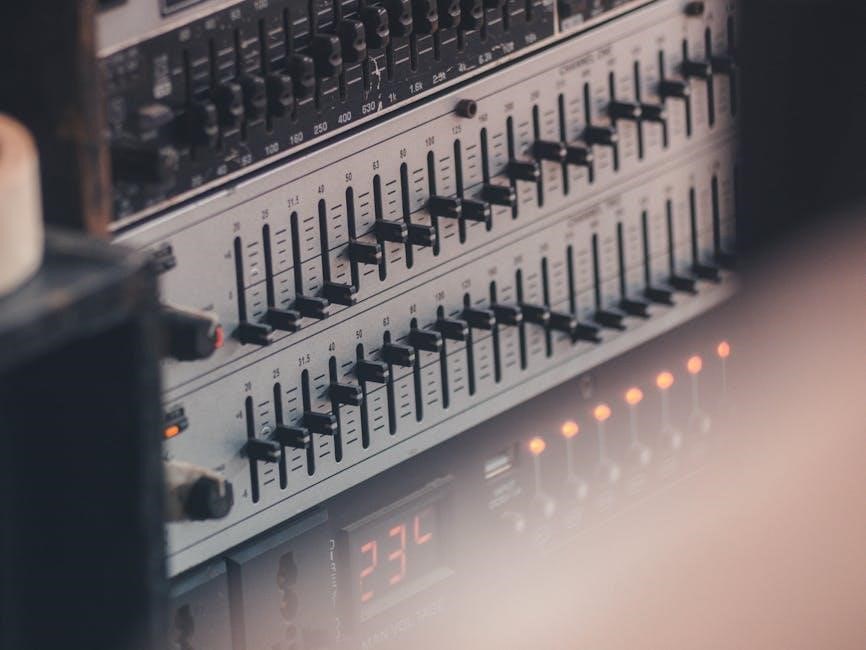
Key Concepts in Small Signal Audio Design
Small Signal Audio Design explores fundamental concepts like signals, amplifiers, and circuit design principles. It delves into voltage amplifiers and transconductance amplifiers, explaining their roles in audio systems.
2.1. Understanding Signals and Amplifiers
In small signal audio design, signals represent sound as electrical voltage fluctuations. These signals are typically low amplitude and require amplification to drive speakers or processing stages. Amplifiers boost signal strength without altering waveform integrity. Voltage amplifiers increase signal voltage, while transconductance amplifiers convert voltage to current. Both types are crucial for maintaining signal fidelity. Proper impedance matching ensures minimal signal loss and distortion. Understanding these concepts is vital for designing circuits that accurately reproduce audio, ensuring clarity and dynamic range in sound systems.
2.2. Voltage Amplifiers vs. Transconductance Amplifiers
Voltage amplifiers and transconductance amplifiers serve distinct roles in audio circuits. Voltage amplifiers increase the voltage level of a signal while maintaining a high input impedance and low output impedance, making them ideal for preamplifier stages. They ensure minimal signal loss and distortion. In contrast, transconductance amplifiers convert input voltage to output current, offering high current drive capability. These are often used in power amplifier stages or when driving low-impedance loads. Understanding the differences is crucial for selecting the right amplifier type based on application requirements, ensuring optimal performance in audio systems. Each design approach impacts the overall sound quality and system efficiency.
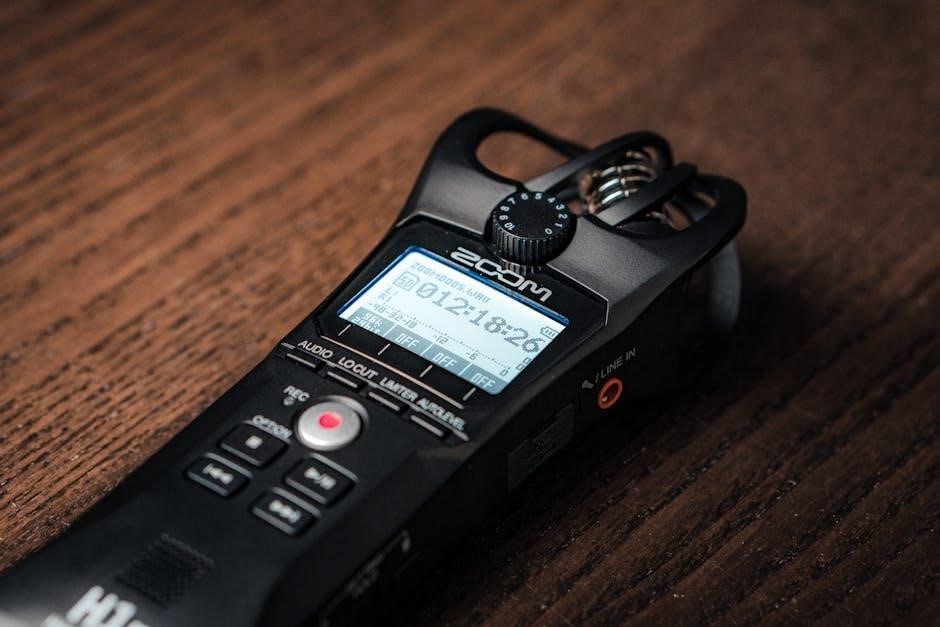
Circuit Design Fundamentals

Understanding circuit design fundamentals is crucial for creating reliable small signal audio systems. Key principles include proper component selection, impedance matching, and noise management to ensure clarity and minimal distortion.
3.1. Designing Preamplifiers and Tone Control Circuits
Designing preamplifiers and tone control circuits is essential for optimizing audio signals before they reach the power amplifier. Preamplifiers boost low-level signals while maintaining high fidelity, ensuring minimal noise and distortion. Key considerations include input impedance matching, gain staging, and noise reduction techniques. Tone control circuits, such as bass and treble adjustments, allow users to tailor the frequency response to their preferences. These circuits often employ operational amplifiers or discrete transistor configurations for precise equalization. Designing these circuits requires careful selection of components, such as resistors and capacitors, to ensure accurate frequency response and minimal phase shift. Proper grounding and shielding are also critical to prevent interference. By combining preamplification and tone control, designers can create versatile and adaptable audio systems that meet diverse listening needs while maintaining sonic integrity.
3.2. Phono Amplifiers and Their Specific Requirements
Phono amplifiers are specialized circuits designed to amplify low-level signals from phonograph cartridges, requiring precise gain and equalization. These amplifiers must account for the unique characteristics of Moving Magnet (MM) and Moving Coil (MC) cartridges, each needing specific gain and impedance matching. RIAA equalization is a critical requirement, ensuring faithful reproduction of the audio signal by applying a standardized frequency response curve during playback. Noise suppression is vital due to the low signal levels, necessitating careful component selection and shielding. Additionally, phono amplifiers must maintain proper impedance matching to prevent signal loss and distortion. The design often involves discrete components or specialized ICs, with a focus on minimizing noise and maintaining high fidelity. Proper implementation ensures optimal audio quality for vinyl playback systems.

Advanced Topics in Audio Circuitry
Explores active crossover networks and balanced audio interfaces, focusing on their design principles and applications in high-fidelity audio systems for optimal sound quality and minimal signal degradation.
4.1. Active Crossover Networks and Their Design

Active crossover networks are essential in audio systems, enabling precise division of audio signals into distinct frequency bands. Unlike passive crossovers, which rely on capacitors and inductors, active crossovers utilize operational amplifiers to maintain signal integrity and reduce distortion. Design considerations include selecting appropriate filter types, such as Butterworth, Bessel, or Chebyshev, each offering unique characteristics in terms of frequency response flatness, phase accuracy, and roll-off steepness. Implementation involves multi-stage amplification and filtering, ensuring minimal noise introduction and stable operation. The use of high-quality components is crucial to achieve low noise and high accuracy, vital in small signal audio design. Active crossovers enhance sound quality by directing specific frequencies to appropriate drivers, optimizing overall system efficiency and audio fidelity.
4.2. Balanced Audio Interfaces and Their Benefits
Balanced audio interfaces are crucial in professional audio systems, offering superior noise rejection and high-quality signal transmission. These interfaces use three-pin connectors, such as XLR, to carry two audio signals: one normal and one inverted. This design cancels out noise picked up in the cable, ensuring cleaner audio reproduction. The benefits include reduced electromagnetic interference, lower distortion, and increased headroom, making them ideal for long cable runs in recording studios and live sound systems. Balanced interfaces are widely used in professional gear due to their reliability and ability to maintain audio integrity. Their noise-rejection capabilities and resistance to external interference make them indispensable in high-fidelity audio applications, ensuring accurate and distortion-free sound transmission.
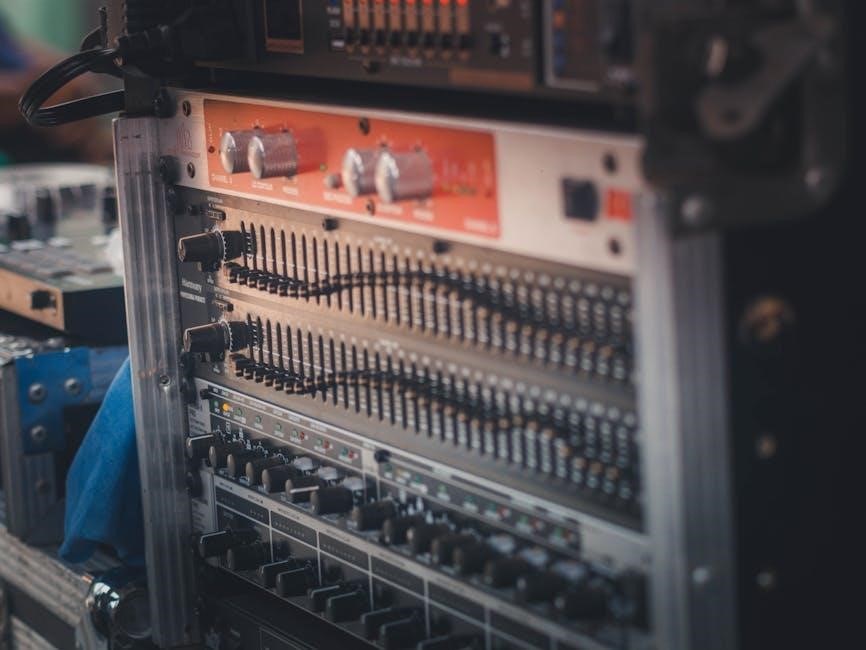
Noise and Interference in Audio Systems
Noise and interference are critical challenges in audio systems, affecting sound quality. Sources include thermal noise, electromagnetic interference, and ground loops. Effective management is essential.
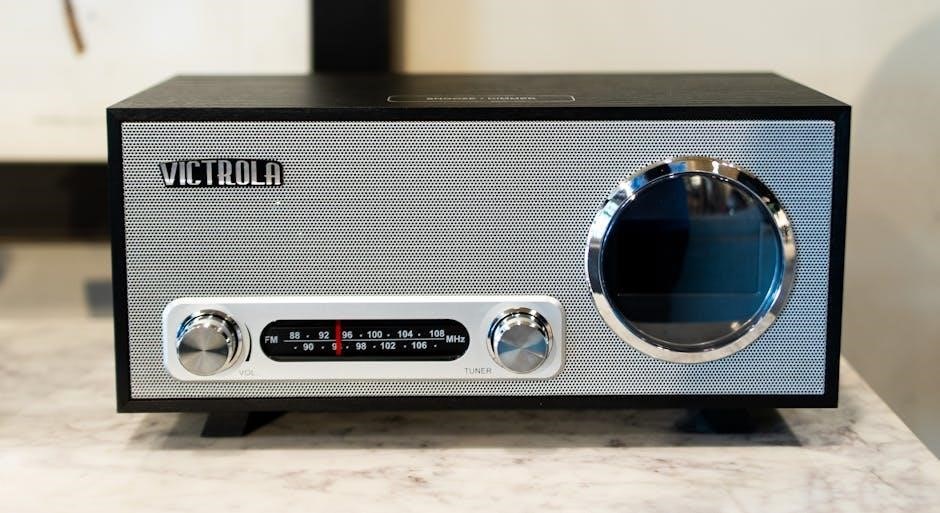
5.1. Sources of Noise and Hum in Audio Circuits
Noise and hum in audio circuits originate from various sources, including thermal noise, electromagnetic interference (EMI), and ground loops. Thermal noise, or Johnson noise, is inherent in resistors and increases with temperature. EMI enters through wires or PCB traces, causing unwanted signals. Ground loops create low-frequency hum when multiple devices share a ground path. Additionally, component noise, such as from discrete transistors or op-amps, and power supply ripple can degrade audio quality. Identifying these sources is crucial for designing low-noise circuits; Proper shielding, filtering, and grounding techniques are essential to mitigate these issues and ensure optimal audio performance.
5;2. Techniques for Minimizing Interference
To minimize interference in audio circuits, several techniques can be employed. Proper grounding is essential to eliminate ground loops, ensuring all components share a common reference point. Shielding cables and enclosures with conductive materials can block electromagnetic interference. Filtering power supplies and signal lines with capacitors and inductors helps suppress high-frequency noise. Using balanced audio interfaces rejects common-mode interference effectively. Additionally, layout and routing of PCB traces should avoid crossing or running parallel to noise sources. Decoupling capacitors placed near active components further reduce local noise. Finally, selecting low-noise components and ensuring proper impedance matching minimize signal degradation. These methods collectively enhance audio clarity and system reliability.
Power Supplies for Audio Circuits
A clean and stable power supply is crucial for maintaining audio quality. Linear supplies are often preferred for their low noise, while proper filtration ensures minimal hum and interference.
6.1. Designing Low-Noise Power Supplies
Designing low-noise power supplies is critical for small signal audio applications, as power supply noise can directly degrade audio quality. Linear power supplies are generally preferred due to their lower noise floor compared to switch-mode supplies. Proper filtration, such as using high-quality capacitors and inductors, helps minimize ripple and hum. Voltage regulation is essential to maintain a stable supply, with options like shunt regulators or low-noise op-amp-based circuits. Grounding and shielding techniques are vital to prevent external interference. Additionally, isolating the power supply from the audio circuitry can reduce the risk of ground loops and electromagnetic interference. Careful component selection and layout ensure optimal performance, making the power supply a cornerstone of reliable audio systems.
6.2. The Impact of Power Supply Quality on Audio Performance
The quality of the power supply plays a pivotal role in determining the overall audio performance of a system. Noise, ripple, and instability in the power supply can introduce hum, distortion, and other artifacts into the audio signal, degrading its clarity and fidelity. A clean and stable power supply ensures accurate signal reproduction, maintaining the dynamic range and frequency response of the audio. Poor power supply quality can lead to increased noise floor, masking subtle details in the music. Additionally, fluctuations in the supply voltage can cause modulation effects, further compromising sound quality. Therefore, achieving a low-noise, well-regulated power supply is essential for preserving the integrity of small signal audio systems.
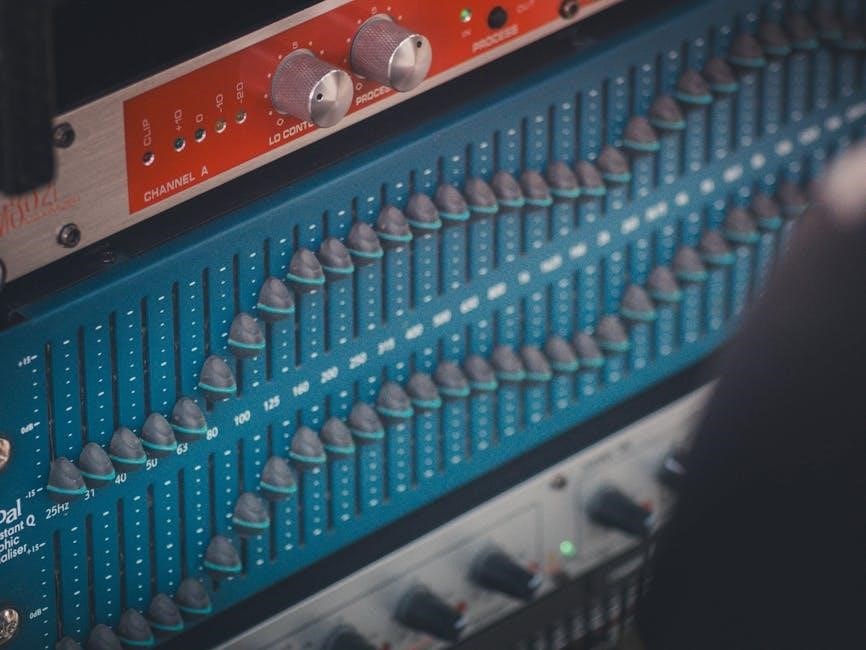
Practical Considerations in Audio Design
Practical considerations in audio design involve optimizing component selection, ensuring proper PCB layout, managing thermal dissipation, and adhering to manufacturing best practices for reliable performance.
7.1. Thermal Management in Audio Equipment
In small signal audio design, thermal management is crucial to ensure reliable operation and optimal performance. Excess heat can degrade components, cause frequency mismatches, and introduce distortion. Key heat sources include power amplifiers, voltage regulators, and active components. Effective thermal management involves proper heatsinking, ventilation, and strategic PCB layout. Selecting components with low power dissipation and high thermal ratings is essential. Thermal interfaces and insulating materials can further mitigate heat-related issues. Additionally, designing for adequate airflow and avoiding thermal hotspots helps maintain consistent operating temperatures; Neglecting thermal considerations can lead to premature component failure and compromised audio fidelity, making it a critical aspect of robust audio system design. Best practices include simulating thermal behavior during the design phase to anticipate and address potential issues early. This ensures long-term reliability and maintains the desired sonic integrity of the audio equipment.
7.2. PCB Layout and Its Influence on Audio Quality
PCB layout plays a critical role in small signal audio design, directly impacting sound quality and system performance. Proper routing of traces minimizes signal degradation, noise coupling, and interference. Grounding and shielding techniques are essential to prevent hum and crosstalk. Separating analog and digital circuits ensures low-noise operation. The placement of components, such as op-amps and resistors, should prioritize signal flow and minimize parasitic capacitance. Using balanced layouts and differential signaling further enhances immunity to external interference. Thermal considerations in PCB design also affect long-term reliability. A well-designed PCB ensures consistent impedance, reduces distortion, and maintains dynamic range. Poor layout practices can introduce artifacts, compromising the fidelity of the audio signal. Thus, meticulous attention to PCB design is vital for achieving high-quality audio reproduction and reliable system operation.
Applications of Small Signal Audio Design
Small signal audio design is crucial in microphones, preamplifiers, and audio interfaces, ensuring high-fidelity sound reproduction in professional and consumer audio equipment, including mixers and signal processors.
8.1. Mixing Consoles and Signal Processing Equipment
Mixing consoles and signal processing equipment rely heavily on small signal audio design to handle low-level audio signals with precision. These systems require high-fidelity circuitry to maintain signal integrity, ensuring minimal distortion and noise. The design of preamplifiers, equalizers, and compressors within mixing consoles depends on small signal audio principles to process audio accurately. Additionally, signal processing equipment like reverb units and effects processors benefit from small signal design to preserve dynamic range and tonal accuracy. Proper implementation of these circuits is crucial for professional audio applications, where even minor signal degradation can compromise the overall sound quality. The techniques outlined in small signal audio design enable engineers to create systems that deliver consistent, high-quality audio performance in recording, live sound, and post-production environments.
8.2. Integrated Circuits for Audio Applications
Integrated circuits (ICs) play a vital role in small signal audio design by providing compact, reliable, and high-performance solutions. Audio-specific ICs, such as operational amplifiers and dedicated audio processors, are designed to handle low-level signals with minimal noise and distortion. These ICs are widely used in preamplifiers, equalizers, and active crossover networks due to their precision and versatility. For instance, the LM741 and TL072 are popular op-amps in audio circuits, offering excellent signal fidelity. Modern ICs often include features like low power consumption, high slew rates, and built-in protection, making them indispensable in contemporary audio equipment; Their small form factor and ease of integration enable designers to create sophisticated audio systems with reduced component counts and improved reliability.
